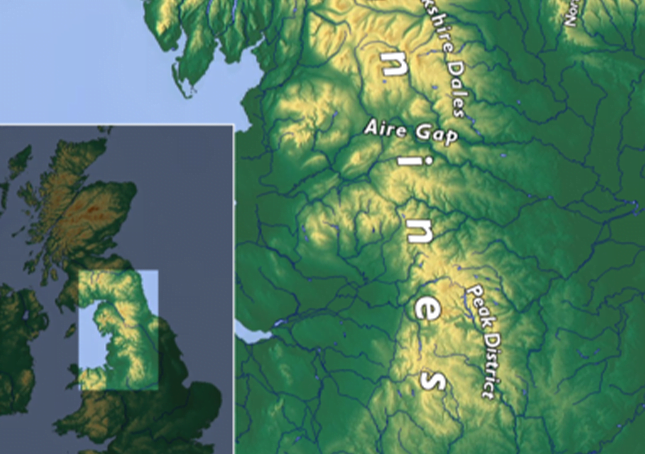Pennines

The Pennines (/ˈpɛnaɪnz/), also known as the Pennine Chain or Pennine Hills,[1] is a range of hills and mountains separating North West England from Yorkshire and North East England.
Often described as the “backbone of England”,[2][3][4] the Pennine Hills form a more-or-less continuous range in most of Northern England. The range stretches northwards from the Peak District at the southern end, through the South Pennines, the Yorkshire Dales and North Pennines to the Tyne Gap, which separates the range from the Cheviot Hills across the Anglo-Scottish border (some definitions include the Cheviot Hills).
South of the Aire Gap is a western spur into east Lancashire, comprising the Rossendale Fells, West Pennine Moors[5] and the Bowland Fells in North Lancashire.[6] The Howgill Fells[7] and Orton Fells[8] in Cumbria are sometimes considered to be Pennine spurs to the west of the range. The Pennines are an important water catchment area with numerous reservoirs in the head streams of the river valleys.
The region is widely considered to be one of the most scenic areas of the United Kingdom.[9] The North Pennines and Nidderdale are designated Areas of Outstanding Natural Beauty (AONB), as are Bowland and Pendle Hill.[10] Parts of the Pennines are incorporated into the Peak District National Park and Yorkshire Dales National Park.[11] Britain’s oldest long-distance footpath, the Pennine Way, runs along most of the Pennine Chain and is 268 miles (429 km) long.
Various etymologies have proposed treating “Pennine” as a native Brittonic/Modern Welsh name related to pen- (“head”) .[14] It did not become a common name until the 18th century and almost certainly derives from modern comparisons with the Apennine Mountains, which run down the middle of Italy in a similar fashion.[13]
Following an 1853 article by Arthur Hussey,[15] it has become a common belief that the name derives from a passage in The Description of Britain (Latin: De Situ Britanniæ),[17] an infamous historical forgery concocted by Charles Bertram in the 1740s and accepted as genuine until the 1840s. In 2004, George Redmonds reassessed this, finding that numerous respected writers passed over the origin of the mountains’ name in silence even in works dedicated to the topological etymology of Derbyshire and Lancashire.[13] He found that the derivation from Bertram was widely believed and considered uncomfortable.
In fact, Redmonds found repeated comparisons with the Italian Apennines going back at least as early as William Camden (1551–1623),[18] many of whose placenames and ideas Bertram incorporated into his work. Bertram was responsible (at most) with popularizing the name against other contenders such as Daniel Defoe’s “English Andes”.[13] His own form of the name was the “Pennine Alps” (Alpes Peninos), which today is used for a western section of the continental Alps. Those mountains (the area around the St. Bernard Pass) derive their name from the Latin Alpes Pœninæ whose name has been variously derived from the Carthaginians,[19] a local god,[20] and Celtic peninus.
The St. Bernard Pass was the pass used in the invasions of Italy by the Gallic Boii and Lingones in 390 BC. The etymology of the Apennines themselves—whose name first referred to their northern extremity and then later spread southward—is also disputed but is usually taken to derive from some form of Celtic pen or ben (“mountain, head”).
Various towns and geographical features have names of Celtic origin, including Penrith, Pen-y-ghent, the River Eden, and Cumbria. More commonly, local names result from Anglo-Saxon and Norse settlements. In Yorkshire and Cumbria, many words of Norse origin, not commonly used in standard English, are part of everyday speech: for example, gill/ghyll (narrow steep valley), beck (brook or stream), fell (hill), and dale (valley).
